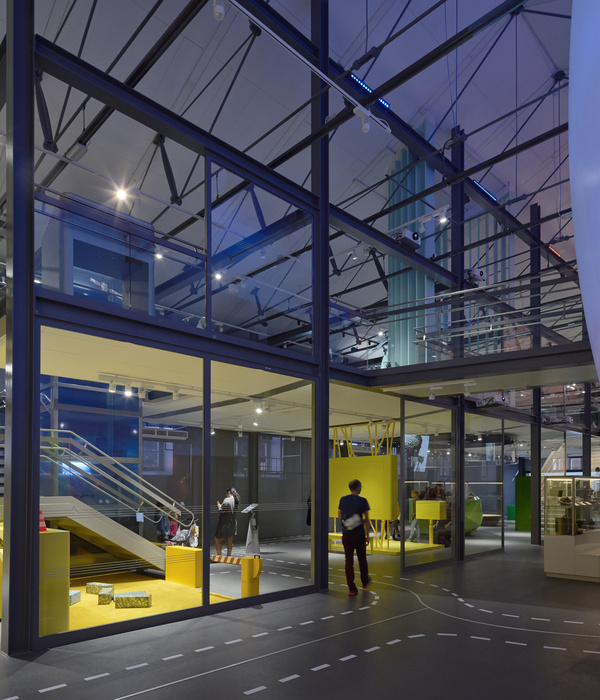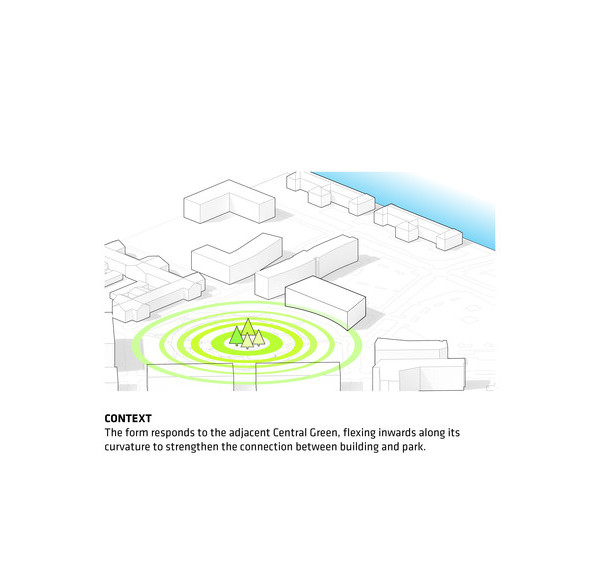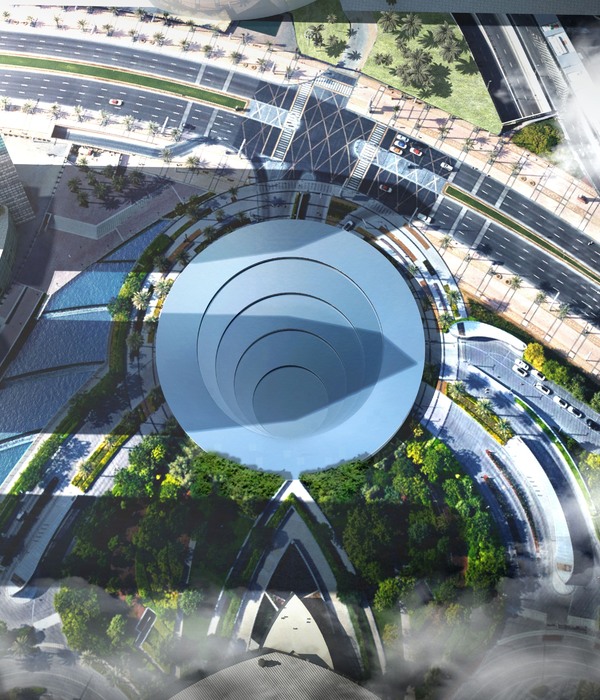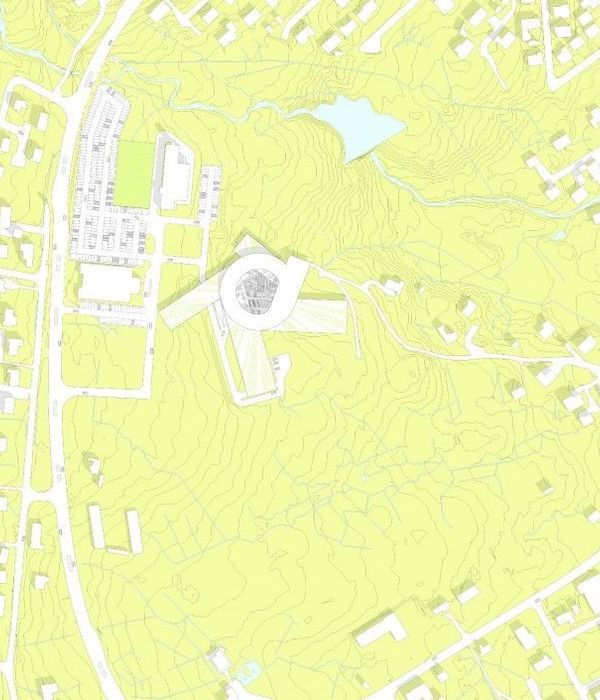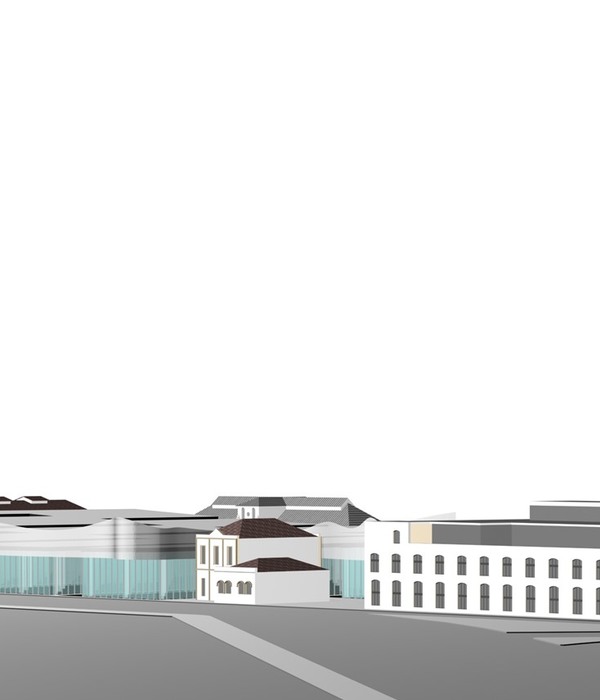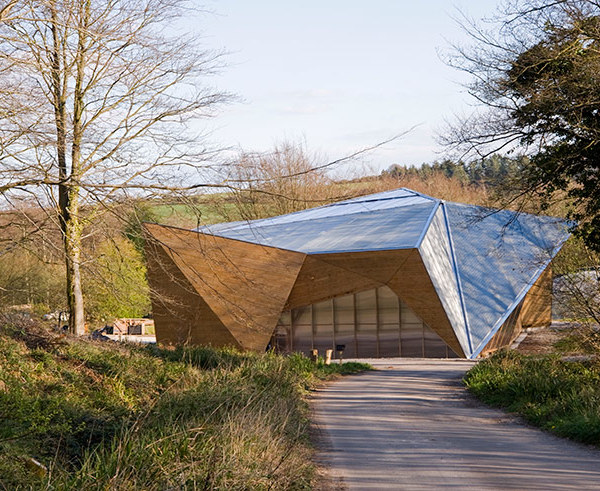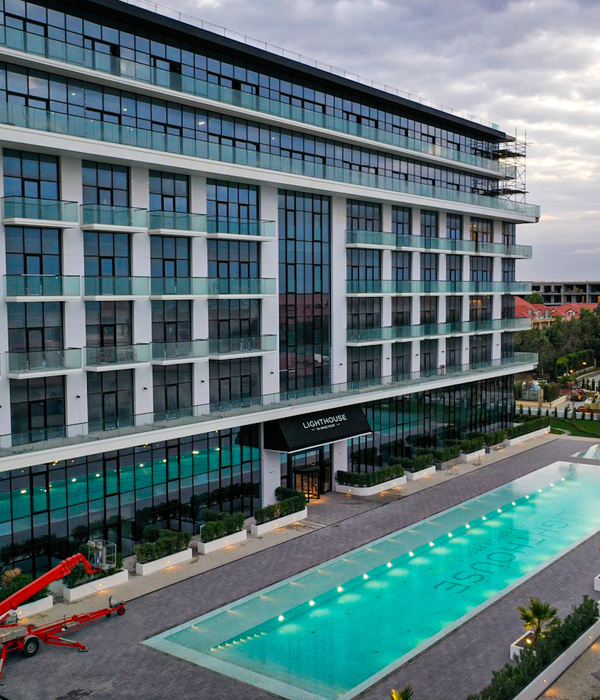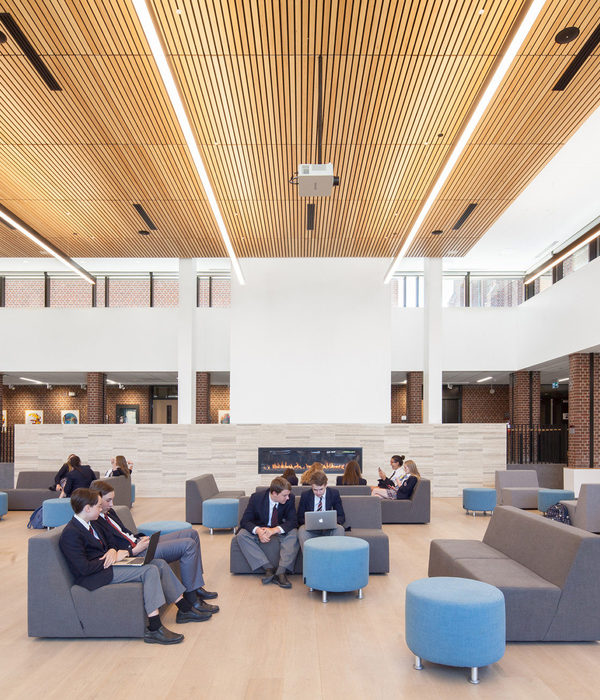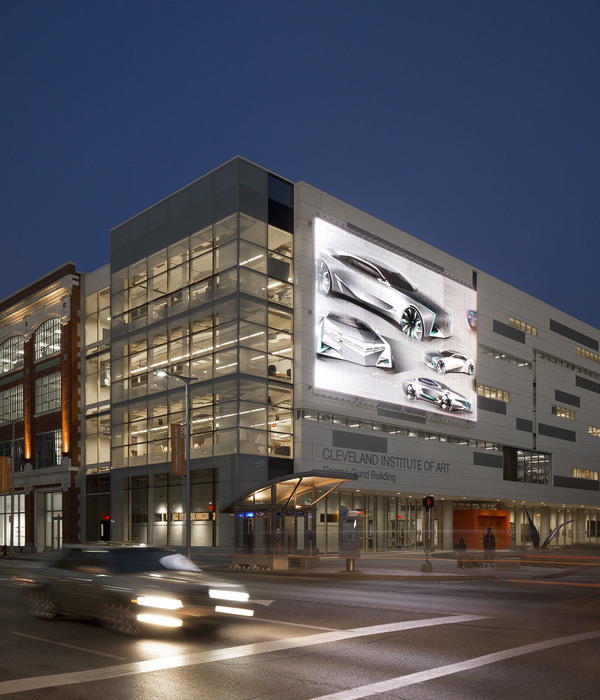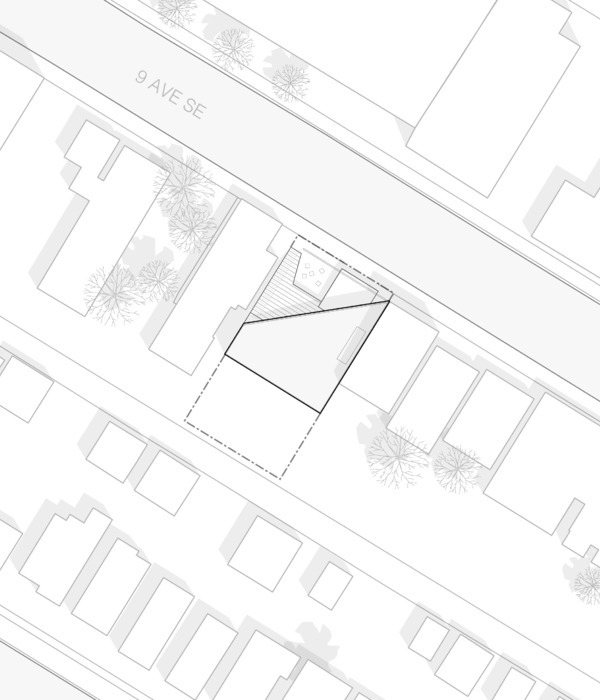本项目的修复策略标准包括:修复与加固原有的砖石结构,保留建筑外观破损的痕迹,特别是在城堡的塔台、空心墙以及建筑表面,避免对原始建筑修复的过分解读。
The general criterion for intervention has been to restore and consolidate the existing masonry, maintaining their ruinous physiognomy, mainly in their crowns, hollows and surfaces, avoiding reinterpretation of the original state.
▼项目鸟瞰,aerial view of the project © Joan Roig
▼项目航拍顶视图,aerial top view of the project © Joan Roig
主要结构元素的加固采用了与原建筑相互兼容的材料,例如:石灰混凝土、不锈钢,以及玻璃纤维增强塑料等,这些材料的色调与纹理能够与原有的砖石结构以及建筑的历史痕迹完美相融,并产生有趣的视觉效果。主要功能元素的加固也秉承了相同的设计理念,例如起到支撑作用的木制构建,则采用了不锈钢连接件进行加固并进行了钛蒸汽处理,木制的表面纹理因此与其他金属与混凝土构件相互呼应。
For the necessary added structural elements, have been used compatible materials such as lime concrete, with stainless steel and glass fibre reinforcing, with tones and textures that integrate with the rest of the interesting historical stratigraphy of the existing and discovered masonry. In the same way, for the necessary added functional elements such as carpentry, it has been used stainless steel with titanium steam treatment, giving it a finish that integrates with the rest of the intervention.
▼主要结构元素的加固采用了与原建筑相互兼容的材料,For the necessary added structural elements, have been used compatible materials © Joan Roig
对于城堡长约70米,高约14米的空心墙区域,主要的干预策略集中在结构加固、预防墙体倒塌风险以及清理并修复墙体表面。建筑师在墙外设置了四个扶壁,除了起到加固地基、修复土地沉降变形的功能外,还起到了填补与加固墙体裂缝的作用。
In the area of the loopholed wall, about 70 meters long and about 14 meters high, the main work has been focused on the structural consolidation, being at risk of collapse, as well as the cleaning and restoration. Outside the walls, four buttresses have been placed, reinforcing the foundation, recovering the exported land and sealing and consolidation of cracks.
▼墙外增设了四个扶壁,four buttresses have been placed outside the walls © Joan Roig
▼扶壁细部,detail of the buttresses © Joan Roig
墙体内部的填充物严重影响了墙的结构,因此被清除,这些填充物的历史可以追溯到卡列斯特战争时期。此外,在本次修复工程期间还出土了大量的考古遗迹,包括三个石灰炉,石灰炉中残留了中世纪的夯土,如今这些历史遗迹均被收录于莫雷拉城堡博物馆中。雨水的渗透是导致城堡建筑老化破损的主要原因,针对这个问题,建筑师专门设计了一套排水路面和管道系统,将雨水引导到现有的室外水池中。
In the interior of the walls, an important volume from Carlist War period fillings has been removed because of they affected structurally the wall, appearing numerous archaeological remains, deposited in the Museum of the Castle of Morella, as well as the finding of three lime ovens, leaving visible medieval rammed-earth that remained hidden. For the collection of rainwater, the main cause of the pathologies caused in the mansory of the Castle, a system of diffuse pavements and pipes has been arranged that direct the waters to a pre-existing outdoor pool.
▼细部,details © Joan Roig
圣弗朗西斯科塔的入口通道也被修复一新,建筑师在城墙的顶端添加了一条全新的人行步道,并用楼梯将步道与入口连接在一起,破损的墙体上也经过了一系列修复处理。如今圣弗朗西斯科塔所有的砖石结构都已被修复,包括坡道及其附属建筑。
The access to the Sant Francesc Tower has been recovered by the execution of the roof in its wall-walks annex, its stairs, and the increase of the semi-demolished wall and the tense. All the masonry has been restored, including the ramp and its annex building.
▼修复与改造后的城堡入口景观,landscape in front of the castle after renovation © Joan Roig
▼俯瞰景观休息区,overlook the landscape area © Joan Roig
▼路面与排水系统,Road surface and drainage system © Joan Roig
▼材料色彩与原建筑以及周围自然环境融为一体,The color of the material blends with the original building and the surrounding natural environment © Joan Roig
▼炮台,battery © Joan Roig
▼细部,details © Joan Roig
帕达拉塔部分,墙体内的填充物也已经被全部移除,以便增设防水与雨水收集系统,建筑恢复了其最原始的状态,向人们展示出它的历史风貌。建筑外部砖石结构已经完全修复,此外,漫步在建筑中时,人们还会惊奇地发现一些有趣的节点,比如嵌入塔内的炮弹,或者隐藏在建筑中的炮艇等。
In the area of Pardala Tower, the entire filling has been emptied to its original level to be able to waterproof and systematize the collection of water, executing his lost cover. The exterior masonry has been restored, with curious finds such as cannonballs embedded in the Tower, or a hidden gunboat.
▼经过修复的室外楼梯,Restored outdoor staircase © Joan Roig
▼室外楼梯入口,entrance steps of the outdoor stairs © Joan Roig
▼俯瞰楼梯,overlook the stairs © Joan Roig
▼增加的安全栏杆与破损的墙体巧妙相融,The added safety railings blend neatly with the damaged walls © Joan Roig
▼填补墙体的景观装置,Landscape installation that fills the wall © Joan Roig
此外,在帕达拉塔的区域,有一处之前从未被发现的古老的架空结构厕所,对于这个地方,建筑师也用木结构对其进行了改进与加固。1838年,卡尔斯特军队就是从这个厕所的下方入口进入城堡的。经过加固与翻修后,入口的支撑结构清晰可见,从而强调出这个重要的历史元素。
In the same area, the ancient overhanging latrines, that remained undetected, have been enhancement, executing a carpentry that allows to emphasize and to leave visible the corbels of this important historical element, to be the point of entry in 1838 of the Carlist troops.
▼经过加固与翻修后的入口,The reinforced and renovated entrance © Joan Roig
▼通道上方的木制支撑结构清晰可见,The wooden support structure above the passage is clearly visible © Joan Roig
▼城堡内部,Inside the castle © Joan Roig
▼黄昏中的建筑,project in the dust © Joan Roig
▼区位图,location plan © Carquero Arquitectura
▼总平面图,master plan © Carquero Arquitectura
▼分析图,Extramuros compositivo previo © Carquero Arquitectura
▼细部详图,renovation details © Carquero Arquitectura
Project: Consolidation and restoration in the area of “Sant Francesc” and “La Pardala” in Morella Castle. Situation: Morella (Castellón, Spain) Architects: Carlos Quevedo Rojas / Carlos Peinado Madueño. (Carquero Arquitectura) Promotor: SG del Instituto del Patrimonio Cultural de España, Dirección General de Bellas Artes (Ministerio de Cultura). Collaborators: Cristina Pérez Prado / Joaquín Martín Rizo / Alejandro Izquierdo Toscano / Gloria Rivero Lamela Technical Architect: Fermín Font Mezquita Archaeologist: Ramiro Pérez Millán Builder: Urcotex Inmobiliaria S.L.U. Construction manager: Josep Brazo i Ramírez Use: Restauración Surface: 1.400 m2 Construction price: 1.511.895,00 € Project date: 2015-2017 Execution date: 2019-2021 Completion date: 27/05/2021 Photographer: Joan Roig
{{item.text_origin}}

